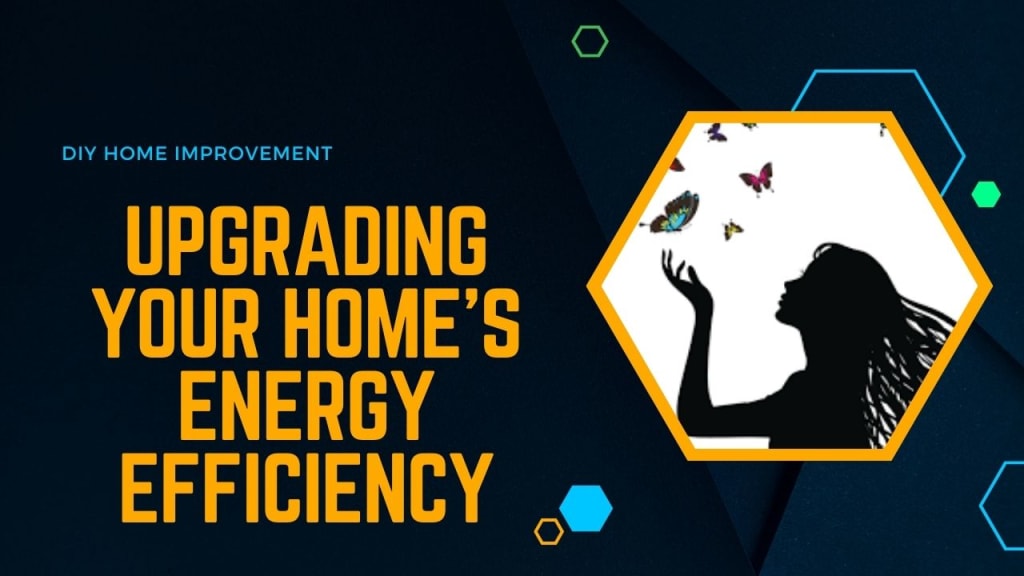Upgrading Your Home's Energy Efficiency
DIY Tips for Savings

In today's world, where energy consumption and environmental concerns are growing, it's important to find ways to make our homes more energy-efficient. Not only does this help reduce our carbon footprint, but it also leads to significant cost savings on energy bills. Fortunately, there are many simple and effective do-it-yourself (DIY) tips that homeowners can implement to upgrade their home's energy efficiency. In this article, we will explore various DIY tips that can help you save energy and money while making your home more sustainable.
Seal Air Leaks:
Air leaks are a common culprit of energy waste in homes. Gaps and cracks around windows, doors, and electrical outlets allow cold or hot air to enter or escape, forcing your heating or cooling systems to work harder. Use weatherstripping, caulking, or foam sealants to seal these leaks and improve your home's insulation. Additionally, don't forget to seal the gaps around pipes, vents, and ductwork. By sealing air leaks, you can prevent energy loss and maintain a comfortable indoor temperature. Not only will this reduce the strain on your HVAC systems, but it will also lead to energy savings and lower utility bills.
Upgrade to LED Lighting:
Traditional incandescent bulbs consume a significant amount of energy and have a short lifespan. Upgrading to energy-efficient LED (light-emitting diode) bulbs is a simple yet impactful DIY project. LED bulbs use up to 75% less energy and last much longer than incandescent bulbs. By replacing your home's most-used light fixtures with LED bulbs, you can lower your electricity bill and reduce the frequency of bulb replacements. LED bulbs are available in various shapes, sizes, and color temperatures, making it easy to find options that suit your preferences and lighting needs.
Install Programmable Thermostats:
Heating and cooling account for a significant portion of home energy consumption. Installing programmable thermostats allows you to set different temperature levels for different times of the day. This means you can automatically adjust the temperature when you're away or asleep, saving energy without sacrificing comfort. Programmable thermostats are relatively easy to install and can lead to substantial energy savings over time. Some advanced models even have Wi-Fi connectivity, allowing you to control the temperature remotely through a smartphone app. By optimizing your heating and cooling schedules, you can reduce energy waste and create a more efficient home environment.
Insulate Your Home:
Proper insulation is essential for maintaining a comfortable indoor temperature and reducing energy waste. Insulate your walls, attic, and floors to prevent heat transfer and minimize the workload on your heating and cooling systems. DIY insulation options include fiberglass batts, spray foam insulation, and reflective insulation. Fiberglass batts are relatively easy to install and can be placed between wall studs and in the attic. Spray foam insulation is ideal for sealing gaps and cracks, providing excellent thermal resistance. Reflective insulation, such as radiant barriers, can be used in the attic to reflect heat away from the living space. Insulating your home not only improves energy efficiency but also enhances soundproofing and overall comfort.
Install Low-Flow Fixtures:
Water consumption also contributes to your home's overall energy usage. By installing low-flow fixtures such as showerheads and faucets, you can significantly reduce water consumption without compromising water pressure. These fixtures aerate the water flow, providing a satisfying shower experience while conserving water and reducing the energy required for water heating. Low-flow showerheads and faucets are available in various styles and designs, making it easy to find options that suit your bathroom aesthetics. With this simple DIY upgrade, you can contribute to water conservation efforts and save on your water and energy bills.
Optimize Appliance Usage:
Home appliances, such as refrigerators, washing machines, and dishwashers, consume a considerable amount of energy. To optimize their usage and minimize energy waste, follow these DIY tips:
- Keep your refrigerator coils clean and well-maintained for efficient cooling.
- Run your washing machine and dishwasher with full loads to maximize energy and water efficiency.
- Air-dry clothes instead of using the dryer whenever possible.
- Use the energy-saving mode on appliances that have this feature.
- Unplug electronics and appliances when not in use to avoid vampire power (standby power) consumption.
These simple practices can lead to significant energy savings over time. By being mindful of your appliance usage, you can reduce your environmental impact and lower your energy bills.
Install Window Coverings:
Windows can be a significant source of heat gain or loss, depending on the season. To improve energy efficiency, install window coverings such as blinds, curtains, or shades. These coverings provide insulation and help regulate the amount of sunlight and heat that enters your home. Close them during hot summer days to block out the heat, and open them during sunny winter days to allow natural warmth into your space. Choose window coverings with thermal properties or opt for double-pane windows for enhanced insulation. By properly managing the heat and light coming through your windows, you can reduce the strain on your HVAC systems and create a more comfortable indoor environment.
Maintain HVAC Systems:
Regular maintenance of your heating, ventilation, and air conditioning (HVAC) systems is crucial for their optimal performance and energy efficiency. Replace air filters every few months to ensure proper airflow and reduce strain on the system. Clean vents and ducts to remove dust and debris that can hinder efficiency. Additionally, consider scheduling professional HVAC maintenance at least once a year to identify and address any issues promptly. A well-maintained HVAC system operates more efficiently, leading to energy savings and improved indoor air quality.
By implementing these DIY tips, you can make a significant impact on your home's energy efficiency. Not only will you reduce your environmental footprint, but you will also enjoy long-term cost savings on your energy bills. Remember, small changes can add up to substantial improvements when it comes to energy efficiency. So, take a proactive approach, start upgrading your home today, and contribute to a more sustainable future while enjoying the benefits of a more energy-efficient and comfortable living space. Your efforts will not only benefit you and your family but also have a positive impact on the planet we all call home.
With a comprehensive approach to energy efficiency, you can create a home that is not only comfortable but also environmentally responsible. Upgrading your home's energy efficiency is a win-win situation that benefits both your wallet and the planet. So, start implementing these DIY tips and enjoy the rewards of a more sustainable and energy-efficient home.
About the Creator
Lindsey Boren
A Virgo woman, mid-30's, from the South (Waco, TX to be exact) who loves reading nonfiction books about science and making jewelry.






Comments
There are no comments for this story
Be the first to respond and start the conversation.